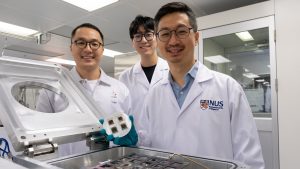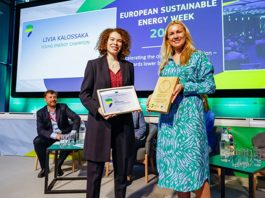Perovskite solar cells that were designed by researchers from the National University of Singapore (NUS) have achieved a groundbreaking world record.
The perovskite solar cells attained a power conversion efficiency of 24.35%, with an active area of 1cm2. This achievement paves the way for cheaper, more efficient, and more durable solar cells.
Before the NUS team’s record-breaking feat, the best-performing 1cm2 cell recorded a power conversion efficiency of 23.7%. This groundbreaking achievement in maximising power generation from next-generation renewable energy sources will be crucial to securing the world’s energy future.
A paper detailing the study, ‘Solar Cell Efficiency Tables,’ was published in Progress in Photovoltaics.
Making breakthrough discoveries in the development of perovskites
Perovskites are a class of materials that exhibit high light absorption efficiency and ease of fabrication, making them promising for solar cell applications.
Perovskite solar cells have achieved several breakthroughs in the past decade, and the technology continues to evolve.
“To address this challenge, we undertook a dedicated effort to develop innovative and scalable technologies to improve our solar cells’ efficiency. Our objective was to bridge the power conversion efficiency gap and unlock the full potential of larger devices,” explained Assistant Professor Hou Yi, the NUS research team leader.
He added: “Building on more than 14 years of perovskite solar cell development, this work represents the first instance of an inverted-structure perovskite solar cell exceeding the normal structured perovskite solar cells with an active area of 1cm2.
“This is mainly attributed to the innovative transporting material incorporated in our perovskite solar cells. Since these cells offer excellent stability and scalability, achieving a higher efficiency than for normal-structured perovskite cells represents a significant milestone in commercialising this cutting-edge technology.”

What makes these perovskite solar cells different to others?
The record-breaking power conversion efficiency was made by successfully incorporating a novel interface material into the cells.
Dr Li Jia, a postdoctoral researcher at the Solar Energy Research Institute of Singapore, commented: “Our findings set the stage for the accelerated commercialisation and integration of solar cells into various energy systems.
“We are excited by the prospects of our invention, which represents a major contribution to a sustainable and renewable energy future.”
Moving towards a greener future
The research team wants to build on this exciting development and push the potential of solar cell technology even further.
Their future focus is to improve the stability of perovskite solar cells, as these materials are susceptible to moisture and can degrade over time.
“We are developing a customised accelerating ageing methodology to bring this technology from the lab to the fab. One of our next goals is to deliver perovskite solar cells with 25 years of operational stability,” Professor Hou said.
Additionally, the team is working on scaling up the cells to modules by expanding their dimensions. This will demonstrate their viability and effectiveness on a larger scale.
Professor Hou concluded: “The insights gained from our current study will serve as a roadmap for developing stable, and eventually, commercially-viable perovskite solar cell products that demonstrate a great power conversion efficiency.
“They will serve as a sustainable energy solution that can help reduce our reliance on fossil fuels.”









